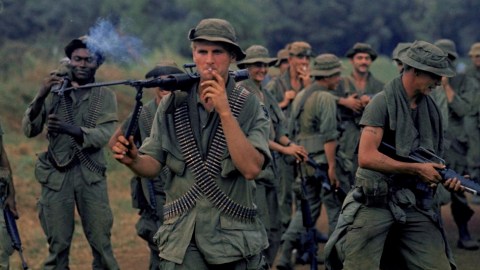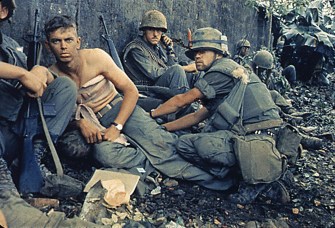Project 100,000: The Vietnam War’s cruel experiment on American soldiers

Flickr user Tommy Truong79
- During the Vietnam War, Robert McNamara began a program called Project 100,000.
- The program brought over 300,000 men to Vietnam who failed to meet minimum criteria for military service, both physically and mentally.
- Project 100,000 recruits were killed in disproportionate numbers and fared worse after their military service than their civilian peers, making the program one of the biggest—and possibly cruelest—mistakes of the Vietnam War.
For many people, joining the military is a way to lift oneself out of poverty, find better opportunities, and get a shot at a better life. It can provide a way to pay for the exorbitant cost of college, job training, a sense of discipline and purpose, all in exchange for a few years of following orders, risking one’s life, and potentially taking others’.
It’s a tradeoff, to be sure, one that not everybody is comfortable with. But for those with the aptitude and the desire, it might be a tradeoff worth taking. The problem in that last sentence, however, is that desire and aptitude don’t always go hand in hand. Sometimes, both are absent entirely. That certainly was the case with Project 100,000.

American soldiers get off helicopters during the operation “Double eagle” against a Vietcong position at Bon Son, south Vietnam, 07 March 1966.
AFP/Getty Images
Lowering standards
Cruelly nicknamed McNamara’s Morons, Project 100,000 was an initiative started under—you guessed it—Robert McNamara during the Vietnam War. In this project, over 320,000 men were either drafted or volunteered for service, nearly all of whom failed the Armed Forces Qualification Test, which is used to determine basic eligibility for military service.
Project 100,000 inductees placed in the lower 10th to 30th percentiles of the test, referred to as Category IV. Normally, candidates who place in Category IV are deemed unsuitable for military service and are told to return to civilian life. Project 100,000, however, was an experiment to see whether military entry requirements could be lowered.
Ostensibly, the project’s goals were to combat poverty. Lyndon B. Johnson had recently begun his War on Poverty program. Thanks to the G.I. bill and other veterans’ programs, military service can be a great way to get out of poverty. But this was a nice bonus to the project’s other purpose: The Vietnam War needed more men, and lowering recruitment standards was one way to get them.
Although about half were volunteers, the other half was drafted, and neither group had any business being in a war zone. The Armed Forces Qualification Test evaluated a variety of domains, all of which were geared toward assessing somebody’s eligibility for service. As a result, Project 100,000 brought men to the war who were ill-equipped in different ways.
Some had physical impairments, some were over- or under-weight, and, most troublingly, many had low mental aptitude—often to the point of being mentally handicapped. Many were illiterate. Since this was an experiment, a small cadre of soldiers were also admitted under the program to act as controls: these were “normal” soldiers.
Once in the military, Project 100,000 soldiers were treated as any other soldier; to do otherwise would void the experiment. Various human resource personnel wrote up anonymized monthly reports on the soldiers, documenting their progress in military life and in war. The results were not good.

A soldier having his wounds treated during Operation Hue City in Vietnam, 06 February, 1968.
NATIONAL ARCHIVES/AFP/Getty Images
A failed experiment
Project 100,000 soldiers were about three times more likely to be killed in action. This is not surprising; in addition to being physically and mentally ill-equipped for war, they were unlikely to qualify for technical training that would otherwise keep them off the front lines. As a result, many of them were used as infantry soldiers.
They were also reassigned 11 times more often than their peers and were between 7 and 9 times more likely to require remedial training. Project 100,000 recruits were more likely to be arrested, too.
For the ones who survived the war, their outcomes were worse than comparable men who did not join military service. They earned $7,000 less per year than their civilian peers, equivalent to a little under $16,000 today. They were more likely to be divorced and less likely to own a business.
The reasons for these differences aren’t entirely clear: it could be the trauma of war, the lack of access to social programs available in civilian life that weren’t available in military life, the possibility that they would have otherwise gone on to complete high school and college—any number of explanations can be offered. But this does show that the ostensible purpose of Project 100,000 was completely invalidated. Offering ineligible soldiers a pass in order to give them a leg up out of poverty through the military did not work.
A review of Robert McNamara’s In Retrospect: The Tragedy and Lessons of Vietnam published in the Washington Post quoted Herb DeBose, a first lieutenant who served in the Vietnam War. He summed up Project 100,000 thusly:
I saw [Robert McNamara] when he resigned from the World Bank, crying about the poor children of the world. But if he did not cry at all for any of those men he took in under Project 100,000 then he really doesn’t know what crying is all about. Many under me weren’t even on a fifth-grade level… I found out they could not read… no skills before, no skills after. The army was supposed to teach them a trade in something—only they didn’t.





